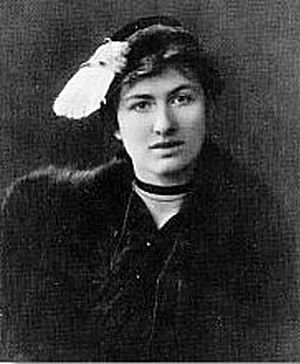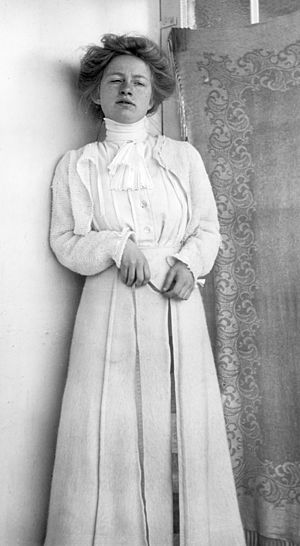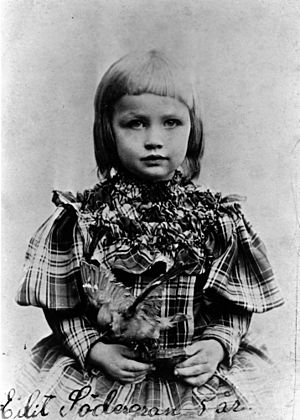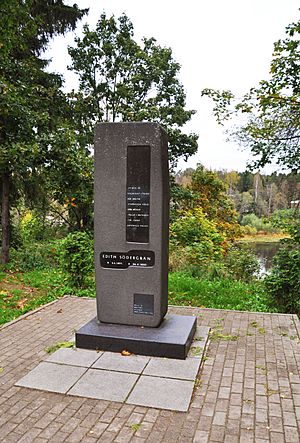Edith Södergran facts for kids
Quick facts for kids
Edith Södergran
|
|
|---|---|

Edith Södergran in 1917
|
|
| Born | 4 April 1892 Saint Petersburg |
| Died | 24 June 1923 (aged 31) Raivola |
| Resting place | Raivola |
| Language | Swedish |
| Nationality | Finnish |
| Education | Petrischule; Saint Peter's School |
| Genre | Poetry |
| Literary movement | Symbolist poetry; futurism |
Edith Irene Södergran (born April 4, 1892 – died June 24, 1923) was a famous Swedish-speaking Finnish poet. She was one of the first poets to write in a modern style in Swedish. Her writing was inspired by French Symbolism, German expressionism, and Russian futurism.
Edith released her first book of poems, called Dikter ("Poems"), when she was 24 years old. Sadly, she died at just 31 years old from tuberculosis, a serious lung disease she had caught as a teenager. She didn't get to see how much people around the world would later love her poetry. Edith Södergran is now seen as one of the greatest modern Swedish-language poets. Her work still inspires many poets and even songwriters today.
Early Life
Edith Irene Södergran was born in Saint Petersburg, Russia. Her parents, Mats and Helena Södergran, were from Finland and spoke Swedish. Edith was their only child.
When Edith was very young, her family moved to a village called Raivola in Finland. Her grandfather bought them a house there. Her father worked at a sawmill, but the company went out of business. The family faced tough times financially. Luckily, her mother's family helped them with some money from an inheritance, which paid off their debts.
Edith went to a girls' school called Petrischule in St. Petersburg. It was a very old and respected school with a strong focus on learning. The school was near The Winter Palace, so Edith saw many important events happening in Russia at the time. She was likely in the city during Bloody Sunday in 1905, when people protested for food and were met with violence.
In 1904, Edith's father became sick with tuberculosis. He died in October 1907, when Edith was only 15. Just a year later, Edith herself would be diagnosed with the same illness.
Edith's mother, Helena, was a strong and intelligent woman. She took care of the family, especially when Edith's father was ill. This experience may have made Edith believe strongly in the power of women. Edith and her mother were very close, and Helena supported Edith's dream of becoming a poet. They often lived in St. Petersburg during school terms, while her father only stayed with them for short periods.
Edith enjoyed taking photos, and there are many pictures of her mother. While Edith had some friends, her mother worried she might be lonely. Some people say that Helena found a foster sister for Edith named Singa, who lived with them during school time. However, other writers disagree and say there's no real proof that Singa existed.
School Days
Edith studied at Die deutsche Hauptschule zu St. Petri (also known as Petrischule) from 1902 to 1909. These years were full of changes and social problems, which probably shaped how Edith saw the world. Some of her early poems from this time even touched on political topics.
The school had students from many different countries, like Germany, Russia, Finland, and Scandinavia. Edith focused on learning modern languages. She became good at German, French, English, and Russian. However, she didn't learn Swedish grammar or spelling in school, even though it was her native language. German was the language she used most with friends and in her first poems. She improved her German even more when she stayed in Switzerland for her health.
Edith was a very smart student who learned quickly. Her classmates thought she was the most talented in her class. She became very interested in her French lessons, partly because of her teacher, Henri Cottier, whom she admired greatly.
Around 1908, Edith decided to write her poems mainly in Swedish. This was a big decision because she wasn't very familiar with Swedish literature, and Finnish-Swedish poetry wasn't very popular then. A relative, Hugo Bergroth, who studied the Swedish language, might have encouraged her. She had already published a poem called Hoppet ("The Hope") in a newsletter. This change to Swedish also showed her clear decision to focus on being a poet.
Her Illness
In November 1908, Edith came home from school feeling unwell. A doctor said she had lung inflammation. On New Year's Day 1909, it was confirmed: Edith had tuberculosis. About a month later, she went to the Nummela sanatorium, the same hospital where her father had been before he died. This made Edith feel uncomfortable there. At that time, it was very hard to recover completely from tuberculosis.
Edith was unhappy at Nummela. She lost weight and felt sad. She felt like the place was more like a prison. During her long days there, Edith dreamed of faraway, exciting places. She often shared these dreams, which made her seem a bit unusual to others.
Her condition got worse, so her family looked for help abroad. They chose Switzerland, which was a leading center for tuberculosis treatment in Europe. In October 1911, Edith and her mother traveled to Arosa in Switzerland. She didn't do well there at first. She saw three different doctors, who all had different ideas for her treatment.
A few months later, she moved to Dr. Ludwig von Muralt's sanatorium in Davos-Dorf. Edith liked her new doctor right away and felt much better there. Dr. von Muralt suggested a procedure called a left-sided pneumothorax. This meant carefully putting nitrogen gas into her lung to make it rest and heal. After May 1912, no more tuberculosis bacteria were found in her lungs, but she still had to be careful with her diet and rest every day.
Her time in Switzerland was very important for Edith. She met many talented people from all over Europe at the sanatorium. She felt a connection with them that she rarely felt in St. Petersburg. Her doctor, von Muralt, became a trusted friend. When he died in 1917, Edith wrote two poems expressing her sadness and memories of her time in Switzerland.
Edith finally felt better. Her cough was gone, and she was more energetic. In the spring of 1914, she went home. However, her illness continued to affect her, and her poetry often showed her struggle against sickness and tiredness.
Her Poetry and Ideas
Edith's first book, Dikter ("Poems"), came out in 1916. It didn't get much attention at first, and some critics were confused. Edith was writing in a new style, using free verse and focusing on small details instead of big descriptions. Her poems, like Dagen svalnar... ("The Day Cools...") and Vierge moderne ("Modern Lady"), showed a new, modern female voice in Swedish poetry.
After the October Revolution in Russia in 1917, Edith and her mother lost all their money because their investments became worthless. Soon after, their home area in Finland became a war zone. Edith knew that some of her classmates had fled St. Petersburg. She read the philosopher Friedrich Nietzsche and found courage in his ideas to face her difficult life.
Her next book, Septemberlyran ("The September Lyre"), was not well understood by the public or critics. Edith tried to explain her poems in a letter to a newspaper in 1918. Instead, she started the first big public discussion about modern, hard-to-understand poetry in Swedish. She gained a lifelong friend and supporter in the young writer Hagar Olsson.
Hagar Olsson became a bright spot in Edith's lonely life in the village. They visited each other and wrote letters until just before Edith's death. Hagar became an important supporter of modern art in Finland and helped people understand Edith's work after she died.
In her next book, Rosenaltaret ("The Rose Altar"), published in 1919, Edith wrote poems about a "sister" figure. This character seemed to be a mix of real life and fantasy, and some details were similar to things Edith and Hagar discussed in their letters. The poem Systern ("The Sister") was quietly dedicated to Hagar Olsson.
Edith's final collection of poems, Framtidens skugga ("The Shadow of the Future"), showed her visions of a new world after wars and disasters. Her home village was a war zone in 1918, and Edith could even hear gunfire from her kitchen. In these poems, she sometimes took on the role of a fortune teller or a leader, like in Eros hemlighet ("Eros' secret").
Even with these grand visions, Edith was an atheist at this time. Her friends said she knew the difference between her own self and the powerful "queens" and "prophets" she wrote about. She believed her writing could help create a new humanity, led by "the strongest spirits" (a concept from Nietzsche).
From the summer of 1920, Edith stopped writing poetry until August 1922. In the autumn and winter of that year, she wrote her last poems. She was inspired by a new magazine called Ultra, which was the first publication in Finland to support modern literature. Ultra praised Edith as a brilliant pioneer and published her new poems. In these final poems, she let go of the idea of being a leader but kept her bold and descriptive language. Some of these last poems are her most loved today.
Edith died on Midsummer Day in 1923 at her home in Raivola and was buried at the village church. Her mother lived in the village until 1939, when she died during an evacuation because of the Winter War. After a peace treaty in 1940, the village became part of the Soviet Union and is now part of Russia. The village has changed a lot since Edith's time, and her grave site is now unknown. However, a statue was put up in Raivola in 1960 to honor her. Her old home is gone, but the foundation stones remain behind the Orthodox church, which was rebuilt using photos of her house.
Her Work and Style
Edith Södergran was a pioneer in modern Swedish poetry and inspired many other poets, including Elmer Diktonius, Gunnar Björling, and Rabbe Enckell. In Sweden, she was an important guide for poets like Gunnar Ekelöf and Karin Boye. Her poems have now been translated into many languages, including Russian, Spanish, and Chinese.
It took many years for her work to be fully recognized. Even 14 years after her death, some writers thought her poetry was important but wouldn't be popular with everyone.
She was often interested in expressionism, a style of art that shows feelings and ideas rather than realistic images. She is now known as a modernist poet.
Some of her most famous poems include Svart eller vitt ("Black or White"), Ingenting ("Nothing"), Min barndoms träd ("My Childhood's Trees"), and Landet som icke är ("The Land which is not"). Her most quoted poem is probably Dagen svalnar... ("The Day Cools..."), which talks about feelings like longing, fear, closeness, and distance.
Edith Södergran's confidence as a poet grew stronger after she read Nietzsche's ideas. In her middle poems, she often wrote as a powerful character – a prophet, a princess, a saint, or just a strong "I" expressing thoughts and feelings. This bold style, especially from a woman writer, was new and exciting for some readers, while others found it challenging.
However, Edith was also realistic. She knew that these powerful characters in her poems were not exactly her own private self. She mentioned this in her letters to Hagar Olsson, and people who knew her said she understood the difference. So, the "ego" in her poems was a role she explored, as seen in poems like Rosenaltaret ("The Rose Altar"), Stormen ("The Storm"), and Vad är mitt hemland ("What Is My Homeland?").
In Den stora trädgården ("The Big Garden"), a beautiful poem from 1920 about artists and a new era, she openly stated that artists have no outward power and shouldn't seek it:
- If I had a big garden
- I would invite all my brothers and sisters there.
- Each one would bring a large treasure.
- We own nothing, thus we could become one people.
- We shall build bars around our garden
- letting no sound from the world reach us.
- Out of our silent garden
- we shall bring the world a new life.
Edith sent this poem to Hagar Olsson in a letter where she also talked about being sick and very poor. Despite her struggles, the letter showed her strong spirit and hope.
See also
 In Spanish: Edith Södergran para niños
In Spanish: Edith Södergran para niños





